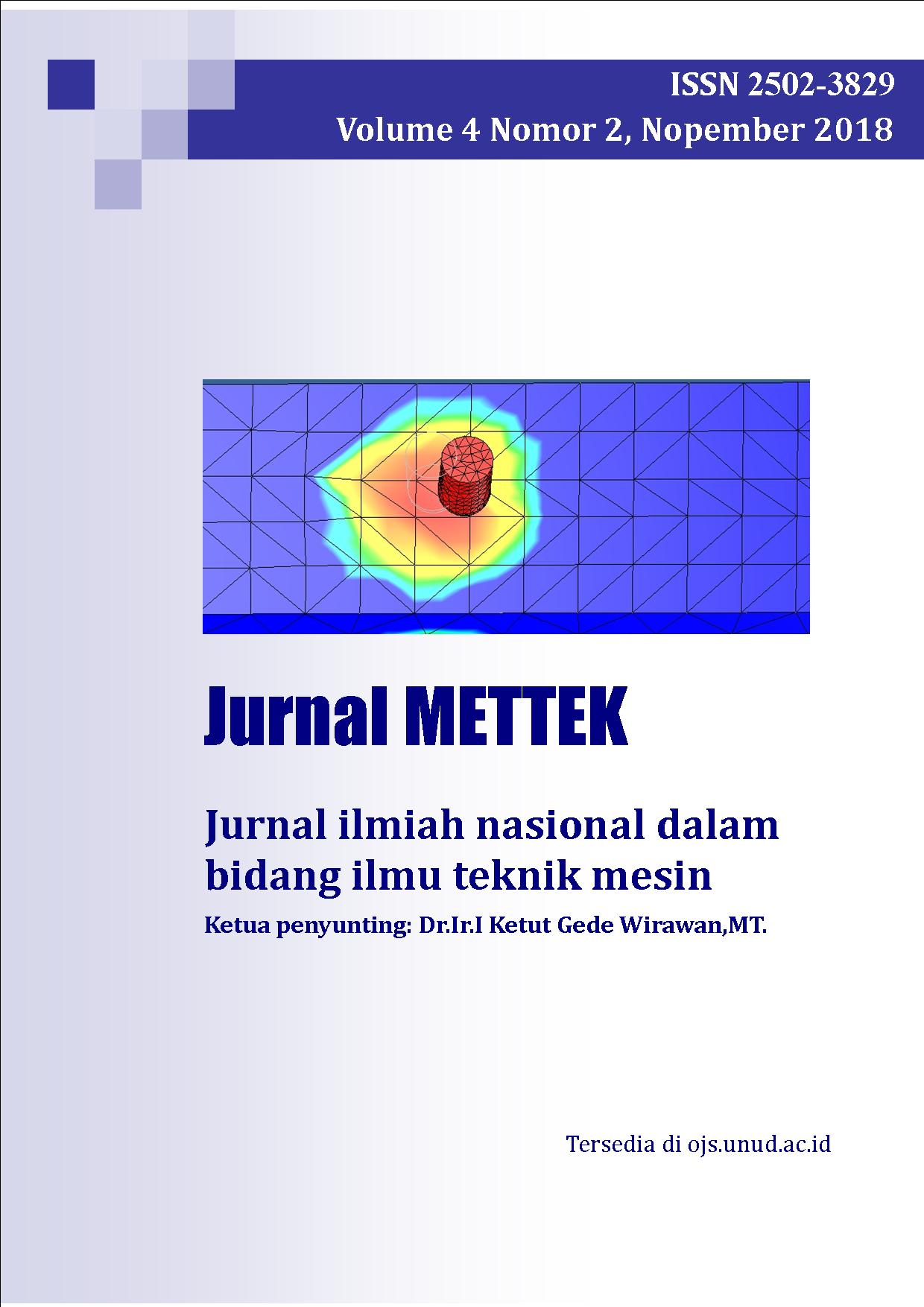Penurunan Temperatur Kondensor pada Sistem Pendingin Central Processing Unit (CPU) Berbasis Cascade Straight Heat Pipe
Abstract
Dalam menunjang kehidupan manusia, teknologi terus mengalami perkembangan. Hal ini terlihat dalam dalam berbagai bidang teknologi seperti elektronik, pembangkit listrik, robotik, permesinan dan lain-lain. Perkembangan CPU terus mengarah kepada dimensi yang semakin kecil namun kinerja meningkat sehingga membutuhkan sistem pendingin yang memiliki kemampuan yang cukup tinggi untuk mampu menjaga kinerja dan umur CPU. Belakangan ini teknologi Heat Pipe mulai banyak digunakan karena memiliki kemampuan kinerja sangat baik dalam mentransfer panas. Kemampuan yang baik dalam menstransfer panas berdampak pada temperatur buang di bagian kondensor yang juga tinggi mencapai 500C -600C. Hal ini akan berdampak kurang baik terhadap komponen lain yang berada di sekitar CPU. Berdasarkan hal tersebut peneliti mencoba menerapkan metode cascade straight heat pipe, guna menurunkan temperatur yang di buang pada bagian kondensor, akan tetapi kinerja pengangkutan panas pada bagian CPU tetap optimal. Hasil penelitian menunjukan bahwa Sistem Pendingin CPU CHP kondensor tunggal mampu menurunkan temperatur kondensor pada kondisi idle sebesar 14,94 0Cdan pada kondisi maksimal sebesar 21,12 0C . Cascade Double kondensormampu menurunkan temperatur kondensor pada kondisi idle sebesar 17,12 0C , dan pada kondisi maksimal sebesar 24,16 0C. Hasilnya lebih rendah bila dibandingkan dengan sistem pendingin NC.Persentasi penurunan temperatur kondensor beban idle dengan menggunakan sistem pendingin CPU CHP terhadap temperatur kondensor Non Cascade adalah dengan menggunakan CHP tunggal kondensor sebesar 28% dan CHP Doublesebesar 32 %. Pada bebanmaksimal adalah dengan menggunakan CHP tunggal kondensor sebesar 35 % dan dengan CHP Double Kondensor sebesar 40 %.
In supporting human life, technology continues to develop. This looks in various fields of technology such as electronics, power generation, robotics, machinery and others - other. Development CPU continues to lead to ever smaller dimensions but increased performance so requires a cooling system that has a high enough ability to be able to maintain the performance and age of the CPU . Lately Heat Pipe technology began to be widely used because it has excellent performance capabilities in heat transfer . Good capability in heat transfer has an impact on the exhaust temperature in the condenser section which also reaches a high of 50 0C -60 0C. This will have an adverse effect on other components around the CPU. Based on this, the researchers tried to apply the cascade straight heat pipe method, in order to reduce the exhaust temperature in the condenser section, but the heat transport performance in the CPU section remained optimal . The results showed that the CPU Cooling System of a single HP condenser was able to reduce the temperature of the condenser at idle conditions by 14.94 0Cand at maximum conditions of 21.12 0C. Cascade Double Condenser able to reduce the temperature of the condenser at idle at 17.12 0C and the maximum condition of 24.16 0C. The result was lower when compared with the Cooling system NC . The percentage decrease in temperature of the idle load condenser by using the CPU CHP cooling system to the temperature of the Cascade Non Ccondenser is to use CHP single condenser of 28 % and CHP Double 32%. On load the maximum is to use a single CHP condenser of 35% and with CHP Double Condenser at 40%.
Downloads
References
S. Brenner, Law in an era of smart technology. Oxford University Press, 2007.
Q. Chen and Y. Huang, “Scale effects on evaporative heat transfer in carbon nanotube wick in heat pipes,” Int. J. Heat Mass Transf., vol. 111, pp. 852–859, 2017.
K. V. Paiva and M. B. H. Mantelli, “Wire-plate and sintered hybrid heat pipes: Model and experiments,” Int. J. Therm. Sci., vol. 93, pp. 36–51, 2015.
A. B. Solomon, K. Ramachandran, and B. C. Pillai, “Thermal performance of a heat pipe with nanoparticles coated wick,” Appl. Therm. Eng., vol. 36, no. 1, pp. 106–112, 2012.
N. K. Gupta, A. K. Tiwari, and S. K. Ghosh, “Heat transfer mechanisms in heat pipes using nanofluids – A review,” Exp. Therm. Fluid Sci., vol. 90, pp. 84–100, 2018.
N. Putra and W. N. Septiadi, Teknologi Pipa Kalor Teori, Desain, dan Aplikasi. Jakarta: Universitas Indonesia, 2014.
L. L. Vasiliev, “Heat pipes in modern heat exchangers,” Appl. Therm. Eng., vol. 25, no. 1, pp. 1–19, 2005.
W. N. Septiadi, I. N. Budiarsa, I. A. Tnunay, I. Desy, W. Ainun, and W. Ula, “Sistem Pendingin Central Processing Unit ( CPU ) Berbasis Cascade Straight Heat Pipe,” Prosiding SNTTM XVII, Oktober, hal. 275-281, 2018.

This work is licensed under a Creative Commons Attribution-NonCommercial-ShareAlike 4.0 International License.

This work is licensed under a Creative Commons Attribution-NonCommercial-ShareAlike 4.0 International License.







